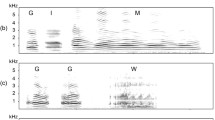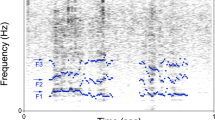Abstract
In 234 copulations, male and female behavioural patterns were collected, especially the vocal pattern for the female. Moreover quantitative structural analysis was performed on 38 of these female copulatory vocalizations. A multifactorial analysis, ANAFAC, was performed to seek relations between (1) utterance of female copulatory call and male and female copulatory behaviour and (2) these patterns and the great variability of female calls. Utterance of female copulatory vocalizations is essentially due to the female’s own copulatory behaviour in periods of intense sexual activity. Long female calls are related to male ejaculation, and those “rich” in harmonics are related to visual and tactile communicatory signals exchanged by the male and the female during a mount. This analysis strongly confirms the tied bond between quality of a call and internal state of the emitter. Long calls, rich in harmonics, may serve as signals maintaining or strengthening the possibly temporary preferential relation between male and sexually receptive female.
Similar content being viewed by others
References
Angst, W., 1974. Das ausdrucksverhalten des Javaneraffen,Macaca fascicularis Raffles. Fortschritte der Verhaltensforschung, No. 15.
Benzecri, J. P. & coll., 1973.L’analyse des données. T. II: L’analyse des correspondances. Dunod, Paris.
Bielert, C., J. A. Czaja, S. Eisele, G. Scheffler, J. A. Robinson, &R. W. Goy, 1976. Mating in the rhesus monkey (Macaca mulatta) after conception and its relationship to oestradiol and progesterone levels throughout pregnancy.J. Reprod. Fert., 46: 179–187.
Bullock, D. W., C. A. Paris, &R. W. Goy, 1972. Sexual behavior, swelling of the sex skin and plasma progesterone in the pigtail macaque.J. Reprod. Fert., 21: 225–236.
Burton, F. D. 1971. Sexual climax in femaleMacaca mulatta. In:Proc. 3rd. Int. Congr. Primat., Zurich 1970, Vol. 3, Karger, Basel, pp. 180–191.
De Benedictis, T., 1973. The behavior of young primates during adult copulation: Observations of aMacaca irus colony.Amer. Anthrop., 75: 1469–1484.
Deputte, B. L., 1978. Etude du baillement chez deux espèces de Cercopithecidae,Cercocebus albigena albigena Gray etMacaca fascicularis Raffles: Recherche de facteurs de causalité et de fonction. Mise en évidence de facteurs socio-bioénérgétiques. Thèse de Doctorat de 3ème Cycle. Univ. de Rennes.
----, in press. Le comportement de “Renserrement” (Herding behaviour”) dans un groupe captif deMacaca fascicularis. Behaviour.
Escoffier-Cordier, B. 1969. L’analyse factorielle des correspondances.Cah. Bur. Univ. Rech. Operat. Fr., no 13: 25–59.
Gautier, J. P. &A. Gautier, 1977. Communication in Old World monkeys. In:How Animals Communicate,T. A. Sebeok (ed.), Indiana Univ. Press, Bloomington, pp. 890–963.
Goustard, M., 1961. La structure sociale d’une colonie deMacaca irus.Ann. Sci. Nat. Zool., Paris, 12(3): 297–322.
————, 1963. Introduction à l’étude de la communication vocale chezMacaca irus.Ann. Sci. Nat. Zool., Paris., 12(5): 707–748.
————, 1968. La séquence d’activités liées à la copulation chez le Macaque crabier,Macaca irus.Ann. Sci. Nat. Zool., Paris, 12(10): 463–474.
Green, S., 1975. Variation of vocal pattern with social situation in the Japanese monkey (Macaca fuscata): A field study. In:Primate Behavior: Developments in Field and Laboratory Research, Vol. 4,L. A. Rosenblum (ed.), Academic Press, New York, pp. 1–102.
Herbert, J., 1970. Hormones and reproductive behaviour in rhesus and talapoin monkeys.J. Reprod. Fert. (Suppl.), 11: 119–140.
Kanagawa, H., E. S. E. Hafez, M. M. Nawar, &S. Jaszcak, 1972. Patterns of sexual behavior and anatomy of copulatory organs in macaques.Z. Tierpsychol., 31: 449–460.
Marler, P., 1965. Communication in monkeys and apes. In:Primate Behavior: Field Studies of Monkeys and Apes,I. DeVore (ed.), Holt, Rinehart & Winston, pp. 544–584.
Rowell, T. E., 1963. Behaviour and female reproductive cycles of rhesus macaques.J. Reprod. Fert., 6: 192–203.
Siegel, S., 1956.Nonparametric Statistics for Behavioral Sciences. McGraw Hill.
Sokal, R. R. &F. J. Rohlf, 1969.Biometry: the Principles and Practice of Statistics in Biological Research. W. H. Freeman, San Francisco.
Stabenfeldt, G. H. &A. G. Hendrickx, 1973. Progesterone studies in theMacaca fascicularis.Endocrinology, 92: 1296–1300.
Zumpe, D. &R. P. Michael, 1968. The clutching reaction and orgasm in the female rhesus monkey (Macaca mulatta).J. Endocr., 40: 117–123.
Author information
Authors and Affiliations
About this article
Cite this article
Deputte, B.L., Goustard, M. Copulatory vocalizations of female macaques (Macaca fascicularis): Variability factors analysis. Primates 21, 83–99 (1980). https://doi.org/10.1007/BF02383826
Received:
Accepted:
Issue Date:
DOI: https://doi.org/10.1007/BF02383826




